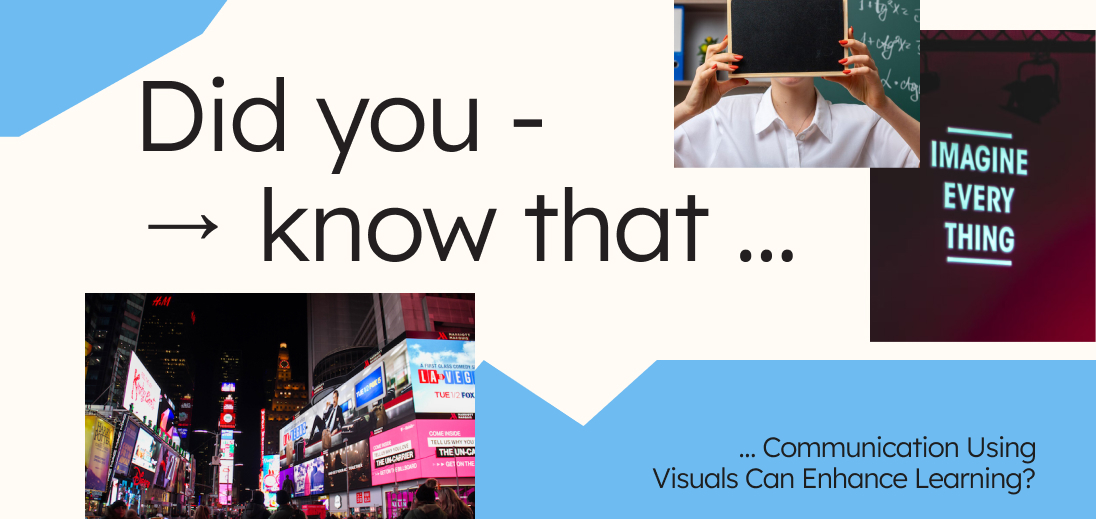Did You Know That…Images Can be Powerful Learning Tools?
Communication using visuals can enhance the learning process. Antalis looks at how we can use visuals to boost our brains.
Communication using visuals can enhance the learning process. Antalis looks at how we can use visuals to boost our brains.
The modern world is filled with visual stimuli. From the images on our screens to advertising billboards on the street and works of art, we are constantly surrounded by images and graphics. Visuals have the power to entertain us and trigger our emotions. They are also powerful tools that can enhance our learning capabilities.
Most of us learn better when information is presented in the form of visual images. Studies have shown that 65% of people identify as visual learners.¹ Using visuals effectively can help you learn a new skill or share your knowledge with others.
What Is Visual Communication?
Communication using visuals is the act of using any type of visual stimuli to convey information to an audience. Visuals can be images, photographs, drawings, graphics, charts, or videos. The basic concept is to use visual elements to make concepts more understandable, engaging, and memorable.
Effective communication using visuals incorporates good communication practices with graphic design techniques. Not only must the message be meaningful and informative, but it must also be presented in a way that is clear and engaging to the audience. Road signs are classic examples of effective communication using visuals.
Visual communication works, but why? As it turns out, there are good scientific reasons why visuals supercharge the learning process.

Credit: Shutterstock
We Can Process Visual Information Incredibly Quickly
Humans can process information incredibly fast when it’s presented in a visual format. Our brains are hardwired to process images much more quickly. After all, humans first began communicating via cave paintings.
The average reading speed is 238 words per minute, and it takes approximately 3,750 to 7,500 milliseconds for our brains to process a sentence.²,³ Each letter we read must be processed into a word and that word processed into a sentence for a piece of text to have meaning.
In comparison, it takes just 0-500 milliseconds for our brains to process complex visual information.⁴ One study showed that the average person could determine the presence of an animal in a photograph in just 150 milliseconds.⁵
Communication Using Visuals Improves Our Memory
We tend to retain information when it is presented in a visual form much more effectively than we do when presented with just text alone. Scientists call this the Picture Superiority Effect.⁶
When we see an image, our brains immediately process it in two different ways. We take in how the image looks overall and what it represents conceptually. The resulting dual encoding from viewing an image helps us retain and recall information more effectively when compared to just reading or hearing words. Studies have shown that we retain 80% of the information contained in a visual after 30 seconds compared to just 60% of the information derived from listening to spoken words.⁷
Visuals Reduce Cognitive Overload
As the pace of information that we need to absorb increases, our attention spans are decreasing.⁸ With so much information coming at us from every possible angle, our brains can be overloaded. Communication using visuals helps to overcome cognitive overload by presenting information in an organized, clear, and easily accessible manner.
Complex topics can be broken down and simplified using graphics, charts, and diagrams. Communication using visuals lets us quickly highlight and absorb key points without the need for lengthy textual explanations.
One study showed that university mathematics students were able to learn complex equations faster and provide more accurate answers when taught with visual presentations as opposed to text or speech.⁹

Credit: Shutterstock
Visual Communication Is Easily Accessible
Perhaps one of the most powerful aspects of using visual communication as a learning aid is its accessibility. Visuals can transcend language barriers and literacy levels.
The previously mentioned example of road signs demonstrates the effectiveness of visual communication. The octagonal shape and red coloring of a Stop sign are instantly recognizable to most people in the world, regardless of their level of education or what language they speak. An essential message is quickly transmitted visually using graphic design best practices of consistency, simplicity, and universal symbolism.
How to Effectively Use Visual Communication
Effectively communicating using visuals involves a combination of design principles and strategic thinking.
Define the message you wish to send or the information you want to transmit. Then consider your audience. Develop a clear, concise message that will resonate with your audience. Consider your audience’s preferences, cultural context, and level of understanding.
Keep your visuals simple. Avoid clutter or unnecessary elements. Every visual element should contribute to conveying your main idea. If there are textual elements, make sure your typography is readable.
Think about the flow of your presentation and prioritize information using size, color, and placement to highlight the most important elements. Make sure your graphics logically convey the information.
Communication using visuals can enhance training by making complex information more accessible and engaging. Using the right visuals can improve comprehension, retention, and overall understanding.
Sources
1 https://www.ncbi.nlm.nih.gov/pmc/articles/PMC6513874/
2 https://pubmed.ncbi.nlm.nih.gov/8632824/
4 https://theses.gla.ac.uk/5161/
5 https://www.ncbi.nlm.nih.gov/pmc/articles/PMC4835101/
6 https://en.wikipedia.org/wiki/Picture_superiority_effect
8 https://www.eurekalert.org/news-releases/490177







